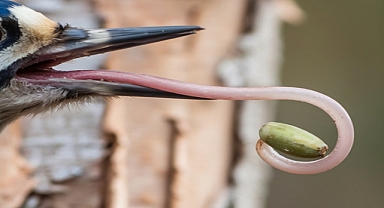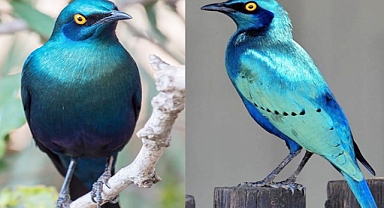A Glimpse into Their Habitat and Adaptability
The Pink-necked green pigeon is a medium-sized bird with predominantly green plumage. Males showcase a stunning pink neck, lending the species its name. They are highly adaptable and can be found in diverse environments, including forested areas, urban parks, and even bustling cities, provided fruiting trees are available. This pigeon is particularly fond of open habitats, showing resilience to human-induced environmental changes. Classified as a species of least concern, it continues to flourish in the wild.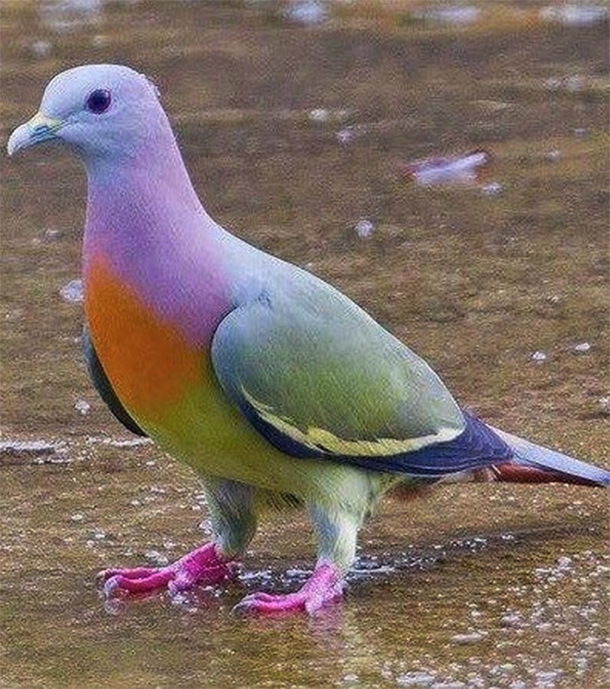 Historical Background and Classification
Historical Background and Classification
First described by Carl Linnaeus in 1771 as Columba vernans, the species was later reclassified under the Treron genus. The Latin name ‘vernans’ translates to ‘brilliant’ or ‘flourishing,’ a fitting description of its radiant appearance. The pink-necked green pigeon is most closely related to the orange-breasted green pigeon, sharing similar traits. Despite past discussions on subspecies classification, most ornithological checklists recognize it as monotypic, with no valid subspecies.
Striking Physical Features and Sexual Dimorphism
Measuring between 25 and 30 cm in length and weighing around 105–160 g, this species exhibits sexual dimorphism. Males possess a gray head, pinkish neck, and upper breast, which transition into a vibrant orange. Their olive-green back and yellow-edged wings create a striking display. The belly is yellowish, and the tail features a distinctive black band with chestnut hues. In contrast, females have a more subdued appearance, with a yellowish belly and greenish crown. Their legs are pink or reddish, and the beak varies from white to pale blue-green.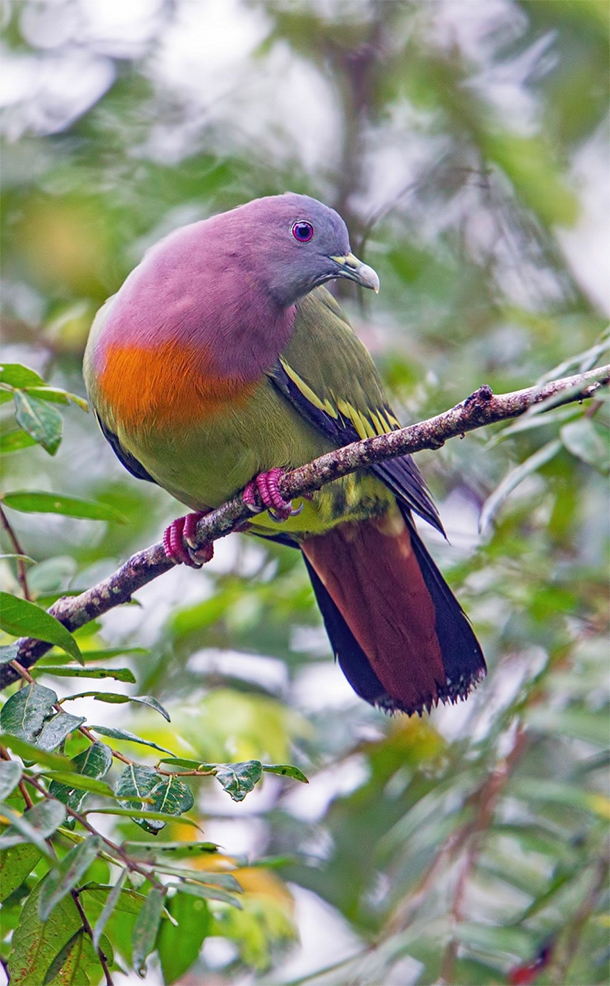 Unique Calls and Vocalizations
Unique Calls and Vocalizations
Unlike typical pigeons known for cooing, Treron pigeons primarily produce whistling and quacking sounds. The pink-necked green pigeon is not particularly vocal but occasionally emits a tri-syllabic whistling call ending in a coo. Additionally, it can produce a rasping ‘krrak krrak...’ sound, mainly during communal roosting or when encountering food.Geographical Range and Habitat Preferences
This species inhabits a vast range, including Thailand, Cambodia, Vietnam, the Malay Peninsula, and numerous Indonesian islands. It favors a variety of environments, from dense forests and coastal mangroves to urban gardens and plantations. While generally preferring lowland regions, it has been recorded at altitudes of 300 m in the Philippines, 750 m in Borneo, and 1200 m in Sulawesi. Though considered non-migratory, some studies suggest localized movements similar to its close relative, the thick-billed green pigeon.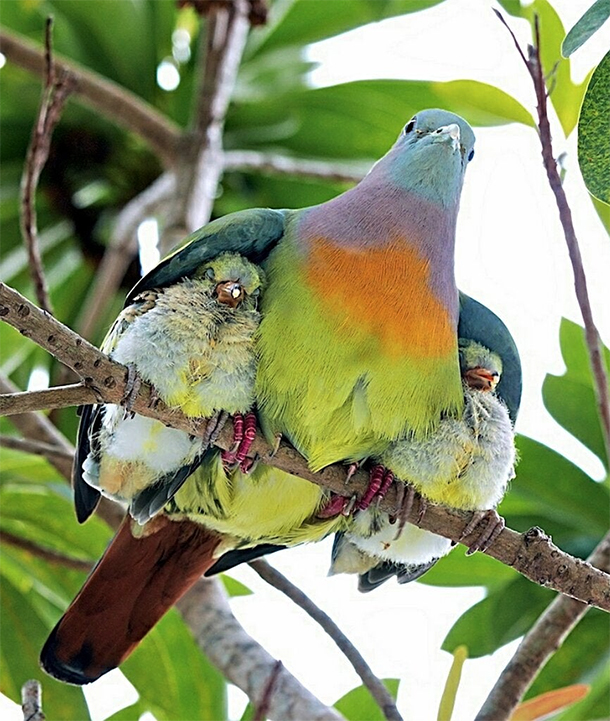 A Resilient Colonizer and Its Historical Significance
A Resilient Colonizer and Its Historical Significance
One of the most fascinating aspects of the pink-necked green pigeon’s history is its role in recolonizing the Krakatoa archipelago after the catastrophic volcanic eruption in 1883. By 1908, it was the only obligate frugivore recorded in the area, highlighting its ability to adapt and disperse seeds essential for ecosystem recovery. The species even colonized the newly formed Anak Krakatau but later disappeared due to predation and small population size. Recently, it has expanded its range to Flores, further demonstrating its adaptability.Feeding Habits and Ecological Role
Primarily frugivorous, the pink-necked green pigeon relies heavily on fruit, especially figs (Ficus). It also consumes the fruit of trees such as Glochidion, Breynia, Vitex, Macaranga, Muntingia, Melastoma, Oncosperma, and Bridelia. Shoots, buds, and seeds are occasionally ingested but remain a minor part of its diet. Studies in Sulawesi confirmed that every observed feeding instance involved fruit consumption. Agile and adept at clinging to fine branches, these pigeons access fruit with ease. Their gizzard, containing grit, helps in digesting seeds, supporting their role as essential seed dispersers.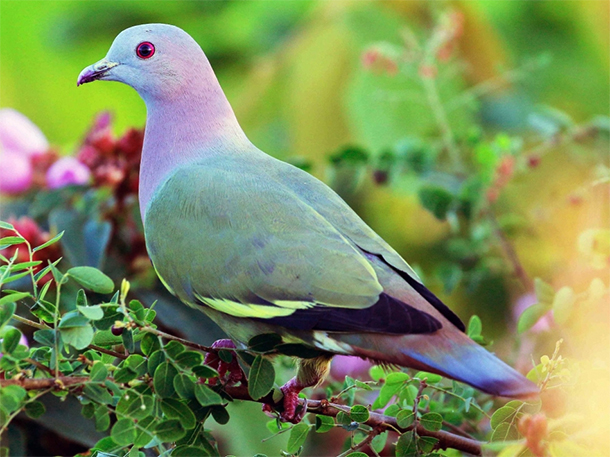 Social Behavior and Breeding Patterns
Social Behavior and Breeding Patterns
This species is highly social, often forming feeding groups and large communal roosts of up to 70 birds or more. Breeding occurs year-round across its range, except in February. The male gathers nesting material while the female constructs the nest—a simple, flimsy structure of twigs. The clutch typically consists of two white eggs, measuring approximately 26.8–28.9 x 20.3–21.8 mm. Both parents share incubation duties and care for the chicks, ensuring their survival in dynamic environments.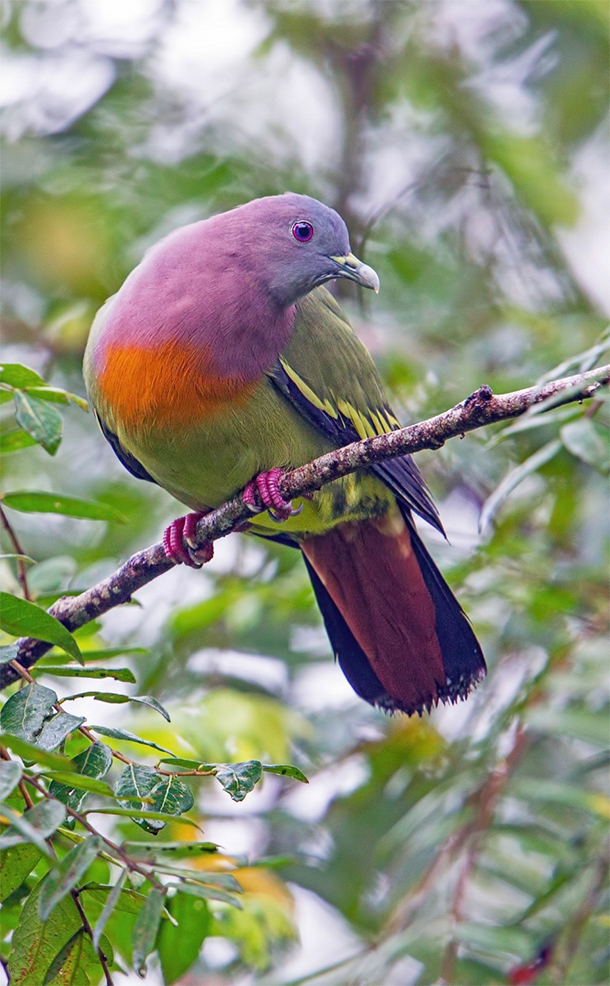 The pink-necked green pigeon is a breathtakingly beautiful bird that challenges the negative stereotypes often associated with pigeons. With its dazzling colors, adaptability, and ecological significance as a seed disperser, this species is a vital part of Southeast Asia’s biodiversity. Whether found in lush forests or urban landscapes, this pigeon continues to captivate bird enthusiasts worldwide, proving that pigeons can be just as mesmerizing as any other exotic bird species.
The pink-necked green pigeon is a breathtakingly beautiful bird that challenges the negative stereotypes often associated with pigeons. With its dazzling colors, adaptability, and ecological significance as a seed disperser, this species is a vital part of Southeast Asia’s biodiversity. Whether found in lush forests or urban landscapes, this pigeon continues to captivate bird enthusiasts worldwide, proving that pigeons can be just as mesmerizing as any other exotic bird species.
The Pink-necked green pigeon is a medium-sized bird with predominantly green plumage. Males showcase a stunning pink neck, lending the species its name. They are highly adaptable and can be found in diverse environments, including forested areas, urban parks, and even bustling cities, provided fruiting trees are available. This pigeon is particularly fond of open habitats, showing resilience to human-induced environmental changes. Classified as a species of least concern, it continues to flourish in the wild.
 Historical Background and Classification
Historical Background and ClassificationFirst described by Carl Linnaeus in 1771 as Columba vernans, the species was later reclassified under the Treron genus. The Latin name ‘vernans’ translates to ‘brilliant’ or ‘flourishing,’ a fitting description of its radiant appearance. The pink-necked green pigeon is most closely related to the orange-breasted green pigeon, sharing similar traits. Despite past discussions on subspecies classification, most ornithological checklists recognize it as monotypic, with no valid subspecies.

Striking Physical Features and Sexual Dimorphism
Measuring between 25 and 30 cm in length and weighing around 105–160 g, this species exhibits sexual dimorphism. Males possess a gray head, pinkish neck, and upper breast, which transition into a vibrant orange. Their olive-green back and yellow-edged wings create a striking display. The belly is yellowish, and the tail features a distinctive black band with chestnut hues. In contrast, females have a more subdued appearance, with a yellowish belly and greenish crown. Their legs are pink or reddish, and the beak varies from white to pale blue-green.
 Unique Calls and Vocalizations
Unique Calls and VocalizationsUnlike typical pigeons known for cooing, Treron pigeons primarily produce whistling and quacking sounds. The pink-necked green pigeon is not particularly vocal but occasionally emits a tri-syllabic whistling call ending in a coo. Additionally, it can produce a rasping ‘krrak krrak...’ sound, mainly during communal roosting or when encountering food.Geographical Range and Habitat Preferences
This species inhabits a vast range, including Thailand, Cambodia, Vietnam, the Malay Peninsula, and numerous Indonesian islands. It favors a variety of environments, from dense forests and coastal mangroves to urban gardens and plantations. While generally preferring lowland regions, it has been recorded at altitudes of 300 m in the Philippines, 750 m in Borneo, and 1200 m in Sulawesi. Though considered non-migratory, some studies suggest localized movements similar to its close relative, the thick-billed green pigeon.
 A Resilient Colonizer and Its Historical Significance
A Resilient Colonizer and Its Historical SignificanceOne of the most fascinating aspects of the pink-necked green pigeon’s history is its role in recolonizing the Krakatoa archipelago after the catastrophic volcanic eruption in 1883. By 1908, it was the only obligate frugivore recorded in the area, highlighting its ability to adapt and disperse seeds essential for ecosystem recovery. The species even colonized the newly formed Anak Krakatau but later disappeared due to predation and small population size. Recently, it has expanded its range to Flores, further demonstrating its adaptability.Feeding Habits and Ecological Role
Primarily frugivorous, the pink-necked green pigeon relies heavily on fruit, especially figs (Ficus). It also consumes the fruit of trees such as Glochidion, Breynia, Vitex, Macaranga, Muntingia, Melastoma, Oncosperma, and Bridelia. Shoots, buds, and seeds are occasionally ingested but remain a minor part of its diet. Studies in Sulawesi confirmed that every observed feeding instance involved fruit consumption. Agile and adept at clinging to fine branches, these pigeons access fruit with ease. Their gizzard, containing grit, helps in digesting seeds, supporting their role as essential seed dispersers.
 Social Behavior and Breeding Patterns
Social Behavior and Breeding PatternsThis species is highly social, often forming feeding groups and large communal roosts of up to 70 birds or more. Breeding occurs year-round across its range, except in February. The male gathers nesting material while the female constructs the nest—a simple, flimsy structure of twigs. The clutch typically consists of two white eggs, measuring approximately 26.8–28.9 x 20.3–21.8 mm. Both parents share incubation duties and care for the chicks, ensuring their survival in dynamic environments.
 The pink-necked green pigeon is a breathtakingly beautiful bird that challenges the negative stereotypes often associated with pigeons. With its dazzling colors, adaptability, and ecological significance as a seed disperser, this species is a vital part of Southeast Asia’s biodiversity. Whether found in lush forests or urban landscapes, this pigeon continues to captivate bird enthusiasts worldwide, proving that pigeons can be just as mesmerizing as any other exotic bird species.
The pink-necked green pigeon is a breathtakingly beautiful bird that challenges the negative stereotypes often associated with pigeons. With its dazzling colors, adaptability, and ecological significance as a seed disperser, this species is a vital part of Southeast Asia’s biodiversity. Whether found in lush forests or urban landscapes, this pigeon continues to captivate bird enthusiasts worldwide, proving that pigeons can be just as mesmerizing as any other exotic bird species.


